HDR: Easier Than You Think
HDR is the abbreviation for "high dynamic range" and, although the technology is less than a decade old, it has achieved the status of being magic that is only within the realm of master photographers. Well, not exactly. Adobe Photoshop has offered HDR merge options for several versions and usable HDR merge options since about CS4. But if you really want to explore the advantages of HDR you're going to need a Photoshop plug-in such as Nik's HDR Efex Pro.
Some boring background is essential to the explanation of HDR so I'll get that out of the way first.
Cameras have shutters that control how long the film or sensor sees a scene and lenses with f/stops that control how much light reaches the sensor in a given time. Shutter speeds are easy. It's obvious to just about anyone that a shutter set at 1/30th of a second allows twice as much light to reach the sensor as a shutter set at 1/60th of a second. The lens's f/stops aren't quite as obvious for two reasons: First, the relationship is inverse because smaller numbers indicate more light and, second, the number are logarithmic. So f/1 allows twice as much light as f/1.2. The full-stop f-numbers are 1.0, 1.2, 2.0, 2.8, 4.0, 5.6, 8, 11, 16, and 32. I've never seen a lens with an f/stop higher than 32, but the scale continues: 45, 64, 90, 128, 180, 256, and so on.
Stay with me for just a bit longer. Each doubling of the light is a "stop" and our eyes can easily handle a dozen stops or more and because our point of focus frequently changes, the apparent range is even higher. Film and digital sensors, on the other hand, have a maximum range of 8 to 10 stops.
So the bottom line is that film and sensors and monitors are incapable of recording and displaying an image the way we saw it and the printing process is even worse.
HDR photography is an attempt to retain, on screen or on paper, the gigantic dynamic range our eyes can tolerate on a medium (screen or paper) that cannot reproduce that range.
How HDR Works
HDR images want to have 3 exposures from your camera:
- The exposure the camera thought was correct.
- An exposure that doubles the light from exposure #1.
- An exposure that halves the light from exposure #1.
You can play with this a bit. I typically shoot a series of 3 images: one as-metered image and then images that are 1.3 stops under and over. Other photographers shoot a series of 5 or 7 images that cover an even wider range of exposures. What you're looking for is a group of images that retain detail in the highlights (you'll get this from the underexposed images), the shadows (you'll get this from the overexposed images), and the mid-tones (these details will come from the "as-metered" images).
The average JPG image can represent 8 or 16 bits per pixel but to record the higher dynamic range for HDR images, you need at least 32 bits per pixel and no monitor or printing press can reproduce that range of colors so what you need is called "tone mapping" and that's what HDR is all about.
You can work with multiple images or a single image. Let's start with a single image. Cats don't care if you make them look funny so I'll use a cat for this exercise.
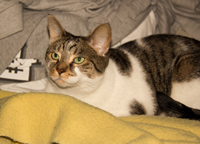 HDR techniques can be used to modify a single image such as this picture of Chloe Kitty.
HDR techniques can be used to modify a single image such as this picture of Chloe Kitty.
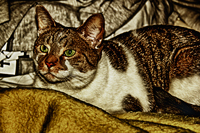 "Crunchy" would describe this version of the image that I created with Nik's HDR Efex Pro plug-in for Photoshop, Lightroom, and Aperture. You may not want this look for your image but this is just one of many HDR effects that Nik's application make available.
"Crunchy" would describe this version of the image that I created with Nik's HDR Efex Pro plug-in for Photoshop, Lightroom, and Aperture. You may not want this look for your image but this is just one of many HDR effects that Nik's application make available.
In most cases, though, you'll want to start with several images.
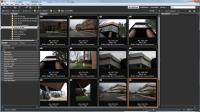 When I returned with photos that I thought might be good for HDR, I had 3 images of each view. I hadn't used a tripod so getting the images in exact registration was important.
When I returned with photos that I thought might be good for HDR, I had 3 images of each view. I hadn't used a tripod so getting the images in exact registration was important.
After stacking the images to reduce clutter, I selected the pictures that show the exterior of Worthington Industries' headquarters.
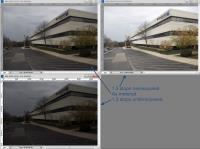 Here are 3 images. The upper left corner is the exposure set by the camera's metering system and it's a good average exposure. The trouble is that detail is missing in dark areas and, to a lesser extent, in bright areas.
Here are 3 images. The upper left corner is the exposure set by the camera's metering system and it's a good average exposure. The trouble is that detail is missing in dark areas and, to a lesser extent, in bright areas.
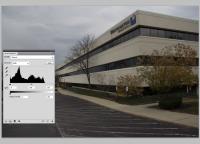 You might think that using a Photoshop levels adjustment layer could bring out detail at both ends of the exposure range. The histogram shows that some of the dark areas are being clipped but there's still quite a bit of headroom at the top of the scale.
You might think that using a Photoshop levels adjustment layer could bring out detail at both ends of the exposure range. The histogram shows that some of the dark areas are being clipped but there's still quite a bit of headroom at the top of the scale.
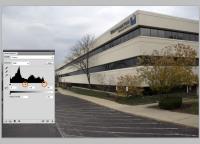 So stretching the histogram helps but it could be better.
So stretching the histogram helps but it could be better.
I usually start with 3 images: As metered, 1.3 stops under, and 1.3 stops over. The number of exposures will always be odd (3, 5, or 7) and sometimes the range will go as far as 3 stops over and 3 under. That kind of range is needed only for the most challenging of images.
I used Photoshop to merge the images. Nik's HDR Efex Pro also includes a merge function, but Photoshop's built-in process does a better job.
The resulting 32-bit image looks a flat here but that's because no tone mapping has been done yet. Photoshop CS5 includes an HDR tone-mapping function but Nik's HDR Efex Pro plug-in will do a much better job.
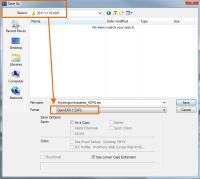 First, though, I need to save the image in EXR format. This file type retains all 32 bits per pixel and that's essential for the bit mapping that will follow.
First, though, I need to save the image in EXR format. This file type retains all 32 bits per pixel and that's essential for the bit mapping that will follow.
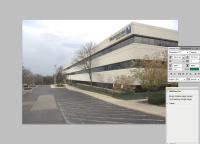 Here's my starting point. Note that there's very little detail in the sky, that the trees look a bit anemic, and that the white parts of the building have no detail.
Here's my starting point. Note that there's very little detail in the sky, that the trees look a bit anemic, and that the white parts of the building have no detail.
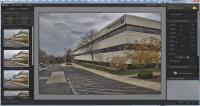 Here's an example using one of the built-in defaults. Now the sky is much more dramatic but the building looks dingy. Fortunately, Nik provides many presets and an array of controls to modify the settings.
Here's an example using one of the built-in defaults. Now the sky is much more dramatic but the building looks dingy. Fortunately, Nik provides many presets and an array of controls to modify the settings.
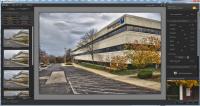 I like this one! The image has detail in the clouds and on the face of the building (the lightest areas) but also retains detail in the darkest part of the image, the parking lot.
I like this one! The image has detail in the clouds and on the face of the building (the lightest areas) but also retains detail in the darkest part of the image, the parking lot.
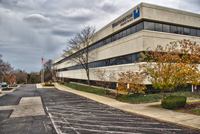 This is the 8-bit output. The sky is no longer just a blob of near white. The colors of the tree's remaining leaves are bright. The shadow areas have detail.
This is the 8-bit output. The sky is no longer just a blob of near white. The colors of the tree's remaining leaves are bright. The shadow areas have detail.
Some additional work might be appropriate in Photoshop to improve the appearance of the pavement because those kinds of corrections aren't something that tone mapping can fix.
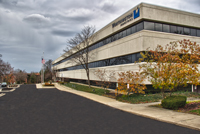 Hokeyness Warning: I didn't have time to do a good job on the pavement, but this will give you an idea of how the pavement might be fixed to make a better image.
Hokeyness Warning: I didn't have time to do a good job on the pavement, but this will give you an idea of how the pavement might be fixed to make a better image.
The edges are bad, the pavement is too regular, patterns are visible—still I think it's good enough to illustrate how an image such as this can be improved.
 Then, just for fun, I thought that I'd see what I could do with this image.
Then, just for fun, I thought that I'd see what I could do with this image.
 And here's what I came up with.
And here's what I came up with.
Is this a good representation? Yes and no. That's an important point about art: If the image pleases you and communicates your intended meaning, it's good. If not, keep trying until you find the representation that works for you.
"For you" is the critical point here.
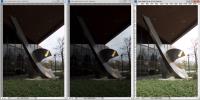 Next let's take a look at an even more challenging image: A shiny metal sculpture in shadows on a cloudy day. The 3 images are normal, under, and over. The sky works better in the underexposed image (middle) and the shadow detail is much improved in the overexposed image.
Next let's take a look at an even more challenging image: A shiny metal sculpture in shadows on a cloudy day. The 3 images are normal, under, and over. The sky works better in the underexposed image (middle) and the shadow detail is much improved in the overexposed image.
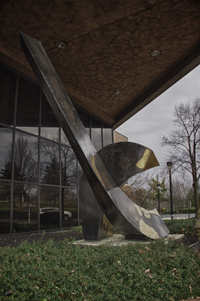 See how much better this image is than any of the 3 images I started with: There's detail in the metal sculpture, detail in the sky, detail in the shadowed underside of the roof, and detail in the branches of the tree.
See how much better this image is than any of the 3 images I started with: There's detail in the metal sculpture, detail in the sky, detail in the shadowed underside of the roof, and detail in the branches of the tree.
Your eyes would register all of these areas of detail as you looked around the scene but no combination of cameras, lenses, and film or digital sensors would ever be able to reproduce all that detail in a single image.
This is what tone mapping makes possible.

 Nik HDR Efex Pro opens the door to dramatic images.
Nik HDR Efex Pro opens the door to dramatic images.
HDR images allow us to see things the way we remember them. HDR images also allow us to create surrealistic images completely unlike anything we've ever seen. For years I've been wrestling with tone mapping and trying to find a method that offers a wide range of controls along with ease of use. Nik HDR Efex Pro is that method.
For more information, visit the Nik website.
Windows 8's Surprising Hardware Requirements
What's it going to take to run Windows 8? Some people were surprised when they found that Windows 7 ran better than Vista on the same hardware. That's one of the things that caused people like me to refer to Windows 7 as "Vista done right" and from the looks of things now, Windows 8 will be even more efficient. (Certain conditions and warnings apply.)
Conditions and warnings. I mention them because judging an unfinished operating system months before its release date and while the software is almost certainly still full of debugging code is tricky. The overall look and feel probably won't change a lot between now and release day but performance could change a lot. So consider this an exercise in applied guessing.
I'm running Windows 8 on two computers, one 32-bit system and one 64-bit system. In both cases, startup and shutdown is faster than with Windows 7 on the same machines (both are dual-boot).
System requirements seem to be less for Windows 8 than for Windows 7. Microsoft says Windows 8 will run on a 1GHz processor with 1GB of RAM. (Double the RAM for 64-bit systems.) In part this is probably because Windows 8 needs to be able to run well on portable devices with low-power processors. Microsoft says that battery life will be somewhat better, too. Of course, if you want decent performance you'll need more powerful hardware.
Windows 8 will use memory more efficiently, too. Many applications use identical code libraries for commonly used functions. If the same library is used by a dozen programs that you have open simultaneously, a dozen copies of the code will be in memory. Microsoft says that the next operating system will check to see what code each program is using and, when more than one copy of library code is in memory all but one copy will be discarded and all of the applications will share a single copy.
I Want My Metro Gnome
Windows 8 has 2 separate interfaces: The standard desktop for notebooks and desktop computers, and Metro for tablets and other portable devices. Running Metro on a system with a keyboard and mouse isn't efficient or enjoyable but I can see how important this will be for users of handheld devices.
The Metro Apps that come with the pre-beta version of the operating system are mostly useless but they do display some of the system's capabilities. You can't actually close a Metro app except by opening the Task Manager and killing it but there's really no need to close a Metro app. As with other applications on other portable devices, applications that aren't in use are simply suspended. Those who are already familiar with portable devices won't have any problem mastering the new interface.
Under Metro, you don't have a Start Menu; you have a Start Screen. As I noted, this is a good choice for handheld devices but those who are used to the regular Start Menu may opt to keep the older interface. Or maybe not. After all, if the Start Screen is visible and I type "wor" and press Enter, Microsoft Word will start. Microsoft hasn't been forthcoming with information about whether users will have to just suck it up and get used to the Start Screen or if the Start Menu will be retained.
It appears to me that the interface has hooks for the Start Menu so my guess is that both interfaces will be available. Microsoft should know that some people just don't take well to radical change even when the change is an improvement.
Fix My PC
Windows 8 offers a new feature that is promising but I haven't yet used it: The option to reset the computer or refresh the computer. A refresh is essentially a clean installation of the operating system except that it retains all of your documents and applications.
I wonder if this will work for computers that have multiple hard drives (no longer an uncommon setup) and whether it will retain all documents that aren't stored in the user's Documents folder. Choosing to reset the computer deletes all of your files and restores the computer to its new, out-of-the-box state. That will be useful when it's time to sell the computer or give it away.
Network Me
Windows networking has been improving and this is a good thing because there was once a time when setting up a new network connection was so difficult on a PC that some people who don't generally use Macs took an Apple computer with them when they traveled because the Mac made connecting to a network so easy.
Windows 7 does a very good job with networks and Windows 8 is even better. If more than one network connection is available, Windows 8 will select the fastest connection. It's also smart enough to differentiate low-cost (LAN or Wi-Fi) connections from all-you-can-gouge cellular connections. If an update is due but all you have is a cellular connection, Windows 8 will delay the update until you're on a more affordable connection.
Wiring Jeff Bezos
The December issue of Wired contains a report on the state of Amazon.com and an interview with CEO Jeff Bezos, who Wired refers to as the guy who "owns the Web in more ways than you think."
The Wired article is well worth the few minutes it will take you to read it and some of what you find will probably surprise you.
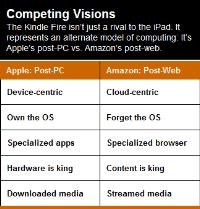 Bezos is well known for taking the long view. Amazon lost money for years and its profit margins today are slim but the company sells a lot so cumulatively it adds up. The newly released Fire tablet isn't a direct competitor for devices such as the Ipad but it could make the Ipad obsolete because it takes a fundamentally different approach: Rather than download and play, the Fire is all about streaming. The Wired article outlines some of the major differences between Fire and Ipad. The chart at the right is from the article.
Bezos is well known for taking the long view. Amazon lost money for years and its profit margins today are slim but the company sells a lot so cumulatively it adds up. The newly released Fire tablet isn't a direct competitor for devices such as the Ipad but it could make the Ipad obsolete because it takes a fundamentally different approach: Rather than download and play, the Fire is all about streaming. The Wired article outlines some of the major differences between Fire and Ipad. The chart at the right is from the article.
Click any of the smaller images for a full-size view.
In releasing the Fire, which is being sold for less than it costs to manufacture, Amazon announced that performance would be off for a while. Wall Street doesn't like the long view and demands immediate gratification so Amazon's stock price suffered. In the article, Bezos is quoted as saying, "If everything you do needs to work on a three-year time horizon, then you’re competing against a lot of people. But if you’re willing to invest on a seven-year time horizon, you’re now competing against a fraction of those people, because very few companies are willing to do that." Amazon typically wants new projects to work within 5 to 7 years. That attitude alone is one of the reasons that Amazon.com makes more than half of the online book sales and owns about 20% of sales for video, music, and consumer electronics.
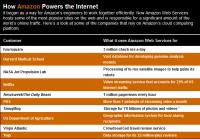 One of the key facts I learned from the article by Steven Levy is how Amazon Web Services (AWS) got started and how large it is today. I had no idea!
One of the key facts I learned from the article by Steven Levy is how Amazon Web Services (AWS) got started and how large it is today. I had no idea!
Initially an internal project, AWS was recognized as a project that Amazon was going to build regardless so Bezos started asking how much more it would cost to develop a system that they could sell to other users. Today AWS is by far the largest player in the market as the chart from Wired shows.
Be sure to visit the Wired website and read the article!
Short Circuits
Speaking of Tablets ...
... and I was just speaking of tablets—Amazon's Fire and the Apple Ipad. And of course there are all those Android devices on the market. But next year there will be a new player: Microsoft with Windows 8 is aiming directly at the tablet market.
Timing is important and with Android devices (not all of which are tablets) selling at the rate of half a million per day, one has to wonder if Microsoft isn't arriving a bit late to the party. That could be but market research shows that demand for tablets is expected to skyrocket next year and some people will simply want a tablet that has the same operating system that's on their PC or laptop.
Microsoft learned some important lessons with Vista and didn't repeat Vista's mistakes in Windows 7. Windows 8 will have a greatly different interface that works on tablet (and, if logic prevails, there will also be a standard interface for those who don't use tablets).
Some of the larger players are already preparing for Windows 8. Dell, HP, and Asus should all have tablets ready to go when the operating system is ready to go.
Concerns about Android devices are common now and could reasonably be expected to increase, particularly in light of the recent revelations about the hidden "Carrier IQ" application that may or may not be sending your every keystroke to someone. It seems odd to be talking about Microsoft and Windows being in a position to have better security than some other vendor but currently the Android's reputation is damaged.
The Year of the Tablet: 2012. It should be an interesting ride.
A Smattering of New Crooked Ploys
The Better Business Bureau says one of my customers complained. I've been invited to a conference, all travel expenses paid. Amazon is sending me a medical device I didn't order. And a bank official writing in Comic Sans wants to share $19,305,050.12 with me. (OK, that last one isn't a new ploy.) What they all have in common, of course, is that they're phony.
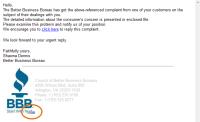 Better Business Bureau: Hello, [Just "Hello"? Nothing else?] The Better Business Bureau has got the above-referenced complaint [Nothing was referenced above.] from one of your customers on the subject of their dealings with you. The detailed information about the consumer's concern is presented in enclosed file. [No file was enclosed.] Please examine this problem and notify us of your position. We encourage you to click here to reply this complaint. [Oh, and the graphical logo at the bottom of the message contained an imperfection, the link didn't go to the BBB, and the message came from a time zone east of Greenwich.]
Better Business Bureau: Hello, [Just "Hello"? Nothing else?] The Better Business Bureau has got the above-referenced complaint [Nothing was referenced above.] from one of your customers on the subject of their dealings with you. The detailed information about the consumer's concern is presented in enclosed file. [No file was enclosed.] Please examine this problem and notify us of your position. We encourage you to click here to reply this complaint. [Oh, and the graphical logo at the bottom of the message contained an imperfection, the link didn't go to the BBB, and the message came from a time zone east of Greenwich.]
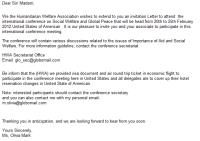 The Conference Invitation: Dear Sir/ Madam, [You don't even know who I am.] We the Humanitarian Welfare Association wishes to extend to you an invitation Letter [Why capitalize "Letter"?] to attend the international conference on Social Welfare and Global Peace that will be head [Will be head?] from 20th to 25th February 2012 United States of American . ["United States of American and what's with the extra space?] It is our pleasure to invite you and your associate to participate in this international conference meeting. [Instead of a conference meeting, I would prefer a seminar program conference meeting gathering.] The conference will contain ["Contain"?] various discussions related to the issues of Importance of Aid and Social Welfare. For more information guideline, [Yeah, I definitely want more information guideline.] contact the conference secretariat. HWA Secretariat Office Email: xxx_xxx@globomail.com Be inform [OK, I be inform.] that the (HWA) we provided visa document and air round trip ticket in economic flight to participate in the conference meeting here in United States and all delegates are to cover up their hotel reservation changes in United State of American. Note: interested participants should contact the conference secretary and you can also contact me with my personal email- x.xxxxx@globomail.com Thanking you in anticipation, and we are looking forward to hear from you soon. Yours Sincerely, Ms, Olivia Mark [Sigh. Some fool probably fell for this and sent money to cover some suddenly discovered expenses.]
The Conference Invitation: Dear Sir/ Madam, [You don't even know who I am.] We the Humanitarian Welfare Association wishes to extend to you an invitation Letter [Why capitalize "Letter"?] to attend the international conference on Social Welfare and Global Peace that will be head [Will be head?] from 20th to 25th February 2012 United States of American . ["United States of American and what's with the extra space?] It is our pleasure to invite you and your associate to participate in this international conference meeting. [Instead of a conference meeting, I would prefer a seminar program conference meeting gathering.] The conference will contain ["Contain"?] various discussions related to the issues of Importance of Aid and Social Welfare. For more information guideline, [Yeah, I definitely want more information guideline.] contact the conference secretariat. HWA Secretariat Office Email: xxx_xxx@globomail.com Be inform [OK, I be inform.] that the (HWA) we provided visa document and air round trip ticket in economic flight to participate in the conference meeting here in United States and all delegates are to cover up their hotel reservation changes in United State of American. Note: interested participants should contact the conference secretary and you can also contact me with my personal email- x.xxxxx@globomail.com Thanking you in anticipation, and we are looking forward to hear from you soon. Yours Sincerely, Ms, Olivia Mark [Sigh. Some fool probably fell for this and sent money to cover some suddenly discovered expenses.]
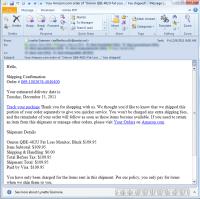 "Amazon" Sends Me a Fat Loss Monitor: The message was a more or less routine looking shipping confirmation from Amazon except for several dead-obvious giveaways:
"Amazon" Sends Me a Fat Loss Monitor: The message was a more or less routine looking shipping confirmation from Amazon except for several dead-obvious giveaways:
- It didn't come from Amazon but from oeflkmfacvulfr@leonlai.net. The domain may exist but the alphabet-soup address probably doesn't. (I didn't even bother to look.)
- The message was sent not only to me but to several team addresses at the office. From the looks of it, everyone in the office bought a fat-loss monitor and that would include the skinny folks on the staff.
- The links to track the package or view the order did not go to Amazon.com but to some other domain where the target was probably a poisoned page poised to infect my machine, or possibly an authentic looking form where I could cancel the order by providing all of my banking information.
I didn't bite.
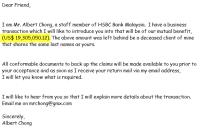 The Bank Guy who uses Comic Sans: I am Mr. Albert Chong, a staff member of HSBC Bank Malaysia. I have a business transaction which I will like to introduce you into that will be of our mutual benefit, (US$ 19,305,050.12). The above amount was left behind be a deceased client of mine that shares the same last names as yours. [You already know the drill on this one. We would share 60/40 or 70/30 or something like that but then some expenses will come up and I'll need to pay them to get my money, which will never arrive. The only thing amusing about this is that the writer used Comic Sans, which is not exactly the most logical choice for bankers and he specified an amount right down to the penny. I guess that's to show how accurate he is.]
The Bank Guy who uses Comic Sans: I am Mr. Albert Chong, a staff member of HSBC Bank Malaysia. I have a business transaction which I will like to introduce you into that will be of our mutual benefit, (US$ 19,305,050.12). The above amount was left behind be a deceased client of mine that shares the same last names as yours. [You already know the drill on this one. We would share 60/40 or 70/30 or something like that but then some expenses will come up and I'll need to pay them to get my money, which will never arrive. The only thing amusing about this is that the writer used Comic Sans, which is not exactly the most logical choice for bankers and he specified an amount right down to the penny. I guess that's to show how accurate he is.]
I really can't feel too sorry for anyone over the age of 10 who falls for any of these cons.
Time for Batteries, Which Are Never Included
Many of the toys and electronic devices that are sold this time of year feature text on the box (in 3-point type) that says Batteries Not Included. So then you see an offer for a huge number of "heavy duty" batteries at an incredibly low price. Do you buy? If you know anything about batteries, you probably don't.
Corporate America sometimes stretches the truth just a little.
Example: In the USB world, there's "Full Speed" and "High Speed". If you see something advertised as "Full Speed", stay away from it because "Full Speed" means that it's an astonishingly slow USB 1.1 device. USB 2 is "High Speed" and USB 3 is faster still. Yet "Full Speed" sounds fast, doesn't it?
The same is true of batteries.
For most electronic devices, you want alkaline batteries and that's what the package will say if that's what is inside. If you don't see the word alkaline, the offer is probably for batteries that are 40-year-old technology. Most heavy duty batteries are old technology (carbon-zinc or zinc-chloride) and they have a lousy shelf life. Store them for a couple of years and they will be dead. Alkaline batteries can be stored for 5 years and lose only about a quarter of their stored energy.
I know because I bought a flashlight this year (batteries not included) and found a package of old heavy duty (carbon-zinc) batteries that had been around for a little over 2 years. There was nothing left.
If you have lots of clocks and TV remote controls, then stock up on "heavy duty" batteries when you can. If not, you'd be wise to avoid them. Essentially, the bottom line is this: If you want the cheapest battery available and you don't care about shelf life or longevity, buy those heavy duty batteries. And lower your expectations.

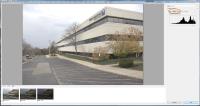

 The author's image: It's that photo over at the right. This explains why TechByter Worldwide was never on television, doesn't it?
The author's image: It's that photo over at the right. This explains why TechByter Worldwide was never on television, doesn't it?
